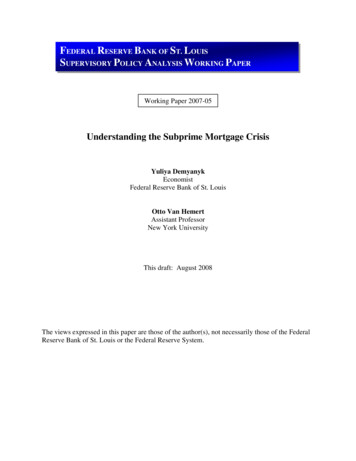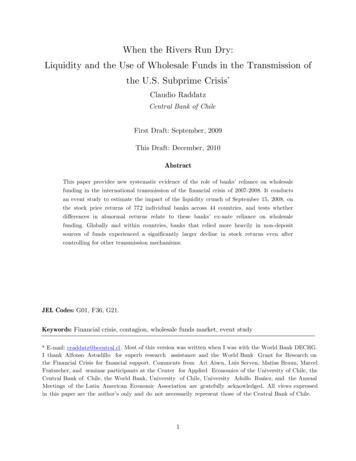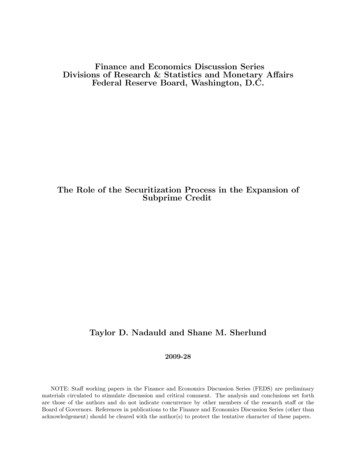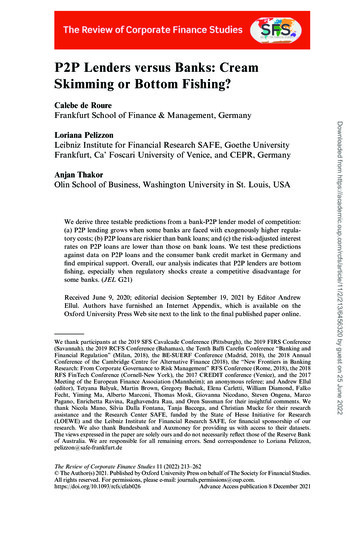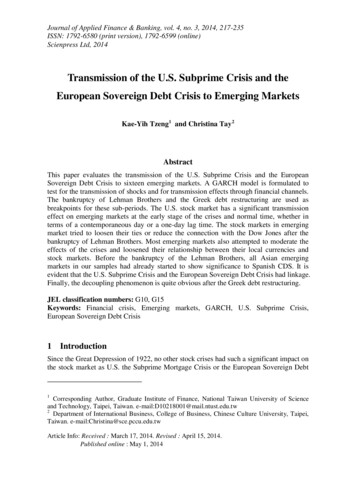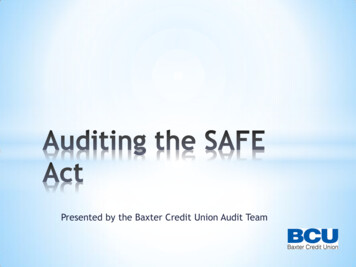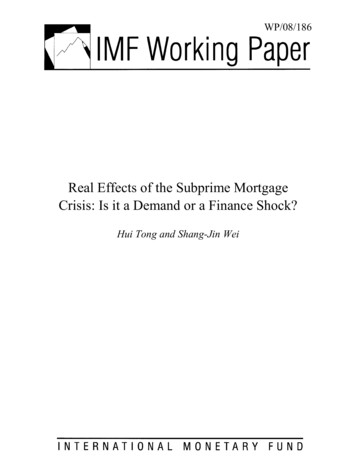
Transcription
WP/08/186Real Effects of the Subprime MortgageCrisis: Is it a Demand or a Finance Shock?Hui Tong and Shang-Jin Wei
2008 International Monetary FundWP/08/186IMF Working PaperWestern Hemisphere DepartmentReal Effects of the Subprime Mortgage Crisis: Is it a Demand or a Finance Shock?Prepared by Hui Tong and Shang-Jin Wei1Authorized for distribution by Tamim BayoumiJuly 2008AbstractThis Working Paper should not be reported as representing the views of the IMF.The views expressed in this Working Paper are those of the author(s) and do not necessarily representthose of the IMF or IMF policy. Working Papers describe research in progress by the author(s) and arepublished to elicit comments and to further debate.We develop a methodology to study how the subprime crisis spills over to the real economy.Does it manifest itself primarily through reducing consumer demand or through tighteningliquidity constraint on non-financial firms? Since most non-financial firms have much largercash holding than before, they appear unlikely to face significant liquidity constraint. Wepropose a methodology to estimate these two channels of spillovers. We first propose anindex of a firm’s sensitivity to consumer demand, based on its response to the 9/11 shock in2001. We then construct a separate firm-level index on financial constraint based on Whitedand Wu (2006). We find that both channels are at work, but a tightened liquidity squeeze iseconomically more important than a reduced consumer spending in explaining cross firmdifferences in stock price declines.JEL Classification Numbers: G2, G3Keywords: liquidity constraint, demand contractionAuthor’s E-Mail Address: Htong@imf.org, shangjin.wei@columbia.edu1We thank Tam Bayoumi, Stijn Claessens, Marcello Estevao, Laura Kodres, Luc Laeven, Neng Wang, ToniWhited, Yishay Yafeh, and seminar/conference participants at the IMF and the International FinanceConference sponsored by Bank of Canada and Queen’s University for helpful comments, and Andrew Swistonand Natalia Barrera Tovar for excellent research assistance.
2ContentsPageI.Introduction .3II.Specification and Key Variables .8A. Basic Specification.8B. Key Data .9III.Empirical Analysis .13A. Basic Results .13B. Evolving Roles of Liquidity Constraint and Demand Contractions .15C. Alternative Measure of Financial Dependence.17D. Placebo Tests.18E. Exposures to Exchange Rate and Commodity Price Movement .19F.Additional Robustness Checks and Extensions .22IV.Conclusion .23References .25Tables1a. Summary Statistics .271b. Correlation Among Variables.272.Change in Stock Price during the Subprime Crisis .283.Alternative Measure of Financial Dependence .294.Does Liquidity Constraint Explain Changes in Stock Prices DuringSeptember 10–28, 2001?.305.Placebo Tests: Stock Price Changes Before the Subprime Crises .316.Adding Exposures to Exchange Rate and Commodity Price Movement.32Figures1.The Log of Stock Index during Subprime Crisis.332.News Count of “Subprime” and “Crisis” .333.Consensus Forecast of U.S. Real GDP Growth .344.Consumer Confidence around Sept. 11th and Subprime Crisis .345.TED (Euro-dollar bond over Treasury Bond) spread around September 11thand Subprime Crisis .356.Cumulative Stock Returns Since August 2007 .367.Key Regression Coefficients from Successively Expanding Samples.37
3"The financial market crisis that erupted in August 2007 has developed into the largestfinancial shock since the Great Depression, inflicting heavy damage on markets andinstitutions at the core of the financial system."International Monetary Fund, World Economic Outlook, April 2008[George Soros] noted, the financial crisis is beginning to have serious effects on the realeconomy, adding: “The extent of that is not, in my opinion, yet fully recognized.”Reuters (New York), April 9, 2008I. INTRODUCTIONThe subprime crisis that began in August 2007 has been called the worst financialcrisis since the Great Depression by George Soros, Joseph Stiglitz, the InternationalMonetary Fund, and other commentators.2 Furthermore, Soros thinks that the crisis may beaffecting the real economy, though the extent of the effect is not yet fully known. In thispaper, we study how the subprime crisis may spill over from the financial sector to the realeconomy. If there is a spillover, does it manifest itself primarily through reducing consumerdemand and consumer confidence? Is there also a supply-side channel through tightenedliquidity constraints faced by non-financial firms? Understanding these channels should helpthe design of an appropriate policy response.The view that the real economy may suffer from a credit crunch as a result of thesubprime meltdown is far from self-evident. As Bates, Kahle, and Stulz (2007) carefullydocument, non-financial firms’ held an abundance of cash prior to the crisis. According tothem, “the net debt ratio (debt minus cash, divided by assets) exhibits a sharp seculardecrease and most of this decrease in net debt is explained by the increase in cash holdings.The fall in net debt is so dramatic that average net debt for U.S. firms is negative in 2004. Inother words, on average, firms could have paid off their debt with their cash holdings.” Giventhe apparent secular downward trend in cash holdings, the net debt ratio was likely evenmore in the negative territory by mid-2007, right before the start of the full-blown subprimecrisis in August 2007. This at least suggests the possibility of no serious liquidity tighteningoutside the financial sector. Probably out of this belief, Federal Reserve Chairman Ben S.Bernanke called strong corporate balance sheets “a bright spot in the darkening forecast”,during his testimony at the U.S. Congress on monetary policy on February 27, 2008.2See /article.html?in article id 437212&in page id 3&ct 5; http://economictimes.indiatimes.com/International Business/Financial crisis worst since 1930s/articleshow/2881608.cms; conomy.subprimecrisis.
4We nonetheless believe that not all non-financial firms are equally well placed toweather the subprime shock. Indeed, as Figure 1a shows, since the subprime crisis broke outin August, 2007, many non-financial firms have experienced a dramatic decline in stockprices. If the crisis represents a tightening of liquidity beyond financial institutions, the effectis likely to be more damaging to those firms that are relatively more liquidity constrained tostart with. Exploring this variation across firms may give us an entry to ascertain the extent towhich the subprime trouble is affecting the real economy. Of course, a tightening of liquiditydoes not need be the only channel through which the subprime crisis could damage the realsector. Demand for firm’s output could be compressed through a loss of consumerconfidence, and hence a reduction in current and future consumer spending.In this paper, we do not study how the subprime mortgage difficulties developed intoa financial sector crisis. Instead, we take it as given that there is a financial sector crisis sinceAugust 2007, and that it started with higher than expected delinquencies in the subprimemortgages. We focus instead on investigating whether and how the financial sector crisisspills over to non-financial firms. One empirical challenge is potential endogeneity of themain explanatory variables. If non-financial firms fare badly when financial firms are notdoing well, one can easily imagine a reverse causality story. Alternatively, both deterioratingperformance of financial institutions and non-financial firms could be caused by a commonthird factor. We develop a methodology to study the mechanisms of the possible spillover,with attention to address the endogeneity issue.We distinguish the demand sensitivity channel from the financial constraint channel.We first propose a sector-level index on the sensitivity to demand shocks, based on stocks’response to the 9/11/2001 shock. [We have to exclude firms in airline, insurance, and defenseindustries as they were directly affected by the 9/11 attack.] We then construct a firm-levelindex on the degree of financial constraints, following Whited and Wu (2006). We furtheruse an index on the intrinsic dependence on external finance by Rajan and Zingales (1998) asa robustness check. It is important to note that financial constraint refers to difficulties inraising external finance of all kinds, not merely in borrowing from banks.As control variables, we add beta, firm size, and book/market ratio from the FamaFrench (1992) three factor model, and the fourth factor of momentum suggested byLakonishok, Shleifer, and Vishny (1994). These factors are often but not always statisticallysignificant. However, our two key regressors: financial constraint and consumer demandsensitivity, are always statistically significant with a correct sign. Our interpretation is thatduring the subprime crisis period, our two variables may reflect aspects of firm risks that arenot completely captured by the three-factor, or the four-factor, model. As an extension, wefurther control for exposure to exchange rates and commodity prices.To address the endogeneity issue, we make sure that our key regressors, the degree ofa firm’s liquidity constraint, and its sensitivity to demand shock, are pre-determined with
5respect to the full-fledged financial crisis. In other words, our thought experiment is this: Ifwe classify non-financial firms into different baskets, based on their ex ante degree ofliquidity constraint, and ex ante sensitivity to demand shocks, would this classification helpus to forecast the ex post stock price performance of these firms? If there is forecastingability associated with these classifiers, would it carry over beyond what can be explained bythe Fama-French three factors and the momentum factor?We find that the answer is yes to both questions. An increase in liquidity constraint byone standard deviation is associated with an additional fall in the stock price by 12.4 percentduring July 31, 2007–March 31, 2008. In comparison, a one standard deviation increase insensitivity to consumer confidence is associated with a contraction in stock price by3.4 percent during the same period. As far as explaining cross-firm differences in the declinein stock prices is concerned, liquidity constraint appears to be a more important channelquantitatively than a contraction in consumer demand.As another way to gauge the quantitative importance of liquidity constraint anddemand contraction, and to track the effect over time, we turn to a “portfolio approach.”Specifically, we classify each stock along two dimensions: whether a stock has a high or lowdegree of liquidity constraint (i.e., whether its Whited-Wu index value is above or below themedian across the firms in the sample), and whether a stock’s sensitivity to a consumerdemand contraction is above or below the median). We then group all stocks into fourequally weighted portfolios: the HH portfolio is a set of equally weighted stocks that arehighly liquidity constrained and highly sensitive to consumer demand contraction; the HLportfolio is a set of stocks that are highly liquidity constrained, but relatively not verysensitive to a change in consumer demand and confidence. The LH and LL portfolios aredefined accordingly. We find that the HH portfolio clearly has the largest decline in stockprices, whereas the LL portfolio has the smallest. The difference between the HH and LLportfolios in terms of the percentage fall in stock price is approximately half of theunconditional fall in the stock price. Moreover, between the two, most of the initial crossfirm difference in the magnitude of the fall in stock prices appears to be related to the crossfirm difference in the degree of liquidity constraints.As our empirical approach is relatively novel, our interpretation stands or falls withwhether our measures of demand sensitivity and liquidity constraint are truly clean and valid.We start by verifying that our index based on firm-level stock price response to the 9/11terrorist attack reflects primarily a demand shock, rather than including a heavy dose ofliquidity shock. It is certainly true that market interest rates went up in the first few daysfollowing September 11, 2001. However, the Federal Reserve took a decisive action to calmmarkets. The market interest rate went back to a level very close to the pre-9/11 level withintwo weeks, indicating that the market regarded the Fed’s action as adequate in restoring theliquidity needed in the economy. At the same time, both economic forecasts of U.S. growthrates and consumer confidence measured by the Michigan consumer sentiment index took a
6sharp downturn immediately following the 9/11 attack. The sharply more pessimistic view ofthe U.S. economy lasted for at least six months. This suggests that the 9/11 shock, measuredover a month’s period after the terrorist attack, reflects mostly a negative shock to consumerconfidence, with virtually no liquidity element. To bolter our interpretation, we also run aregression of stock price declines during the first month after the 9/11 shock on the WhitedWu measure of liquidity constraints (using the end-of-2000 values of firm characteristics toensure that the variable is pre-determined). Cross-firm differences in liquidity constraintsturn out to be unimportant in explaining cross-firm differences in stock price declines duringthis period. This further suggests that the 9/11 index is not likely to be heavily contaminatedby a liquidity constraint element.We now come to the validity of our key measure of firm-level liquidity constraint. Asa robustness check, we replace the Whited-Wu index of liquidity constraint by an index ofsector-level intrinsic dependence on external finance proposed by Rajan and Zingales (1998).This new index also has a negative and statistically significant coefficient: firms that arenaturally more reliant on external finance suffer a greater fall in stock prices. As an extension,we can also combine the Whited-Wu (WW) index and the Rajan-Zingales (RZ) index in thesame regression as they measure somewhat different things. We find that even among firmslocated in external-finance dependent sectors (according to the RZ index), those that arerelatively more liquidity constrained (according to the WW index) experience a particularlybig fall in stock prices.To ensure that our key regressors really pick up something unique to the subprimecrisis period, we conduct a placebo test for the period of May 30, 2007–July 30, 2007. Weverify by a search of an electronic news database that the subprime problem was not yetwidely recognized as a crisis during this period. We regress a change in stock price on firmlevel liquidity constraint (as measured by the Whited-Wu index) and firm-level sensitivity todemand shock (as measured by our 9/11 index). It turns out that neither index is statisticallysignificantly different from zero during this period. This suggests that prior to the outburst ofthe crisis in August, 2007 stock price movements were not systematically related to liquidityconstraint or demand sensitivity (as forward-looking stock prices had already priced in anyknown liquidity and demand shocks as of then).Since the subprime crisis broke out in August, 2007, there are other changes in theeconomic environment. The most prominent factors are a dramatic depreciation of the U.S.dollar relative to the euro, the yen and other currencies, and a steady rise in the oil price andother commodity prices. If one believes in the validity of the Fama-French three-factor model,one could understand our exercise as asking whether an ex ante classification of firms interms of their liquidity constraint and sensitivity of demand help to explain firms’ subsequentchange in stock prices beyond what can be explained by the three factor model. This is awell-defined exercise by itself. In a sense, exposures to currency and commodity pricemovement should have been captured by the three factors (plus momentum) already.
7Nonetheless, as an extension, we make an attempt to account for the role of exchange rateand commodity price movements in explaining stock price changes since August, 2007.As we don’t have systematic information on a breakdown of a firm’s revenue andcost by country/currency from any standard database, we have to develop an indirectapproach to gauge a firm’s exposure to these currency and commodity price movement. Wefollow a three-step procedure. First, using weekly information during 2004–2006, weestimate a firm’s sensitivity to movement in major currencies and commodity prices using aregression framework. Second, we collect firm-level sensitivity coefficients to currency andcommodity price movement from the previous regressions, and combine them with the actualmovement in major exchange rates and commodity prices after August 2007 to form ameasure of each firm’s realized exposure to these factors. Third, we add the firm-levelexposure to these factors as additional control variables in our main regressions.Reassuringly, both liquidity constraint and demand sensitivity continue to have negative andstatistically significant coefficients. In fact, the size of the point estimates is hardly affectedby the addition of the exposure to currency and commodity price movement. At the sametime, and equally reassuringly, we find that some of the exposures, especially the hike inenergy price, do have a statistically significant effect on the stock prices of many firms.This slew of robustness checks reinforce our interpretation that both liquiditytightening and a loss of consumer confidence have negatively affected non-financial firmsduring the subprime crisis. Furthermore, in terms of relative stock price movement, a tighterliquidity constraint appears to be quantitatively a more significant channel.This paper is linked to the literature on credit crunch (for example, Bernanke andLown, 1991; Borensztein, and Lee, 2002; Dell’Ariccia, Detragiache, and Rajan, 2008, amongothers). We differ from the earlier literature by considering demand sensitivity together withliquidity constraint. Our measures of liquidity constraint, especially the use of the WhitedWu index, are new. More notably, our measure of sensitivity to a demand shock is novel.This paper is also related to a small but growing literature on the origin and consequences ofthe subprime problem as a financial crisis, including recent work by Mian and Sufi (2008),Reinhart and Rogoff (2008), Dell’Ariccia, Igan and Laeven (2008), and Greenlaw et al.(2008). As of now, we have not come across a paper directly documenting and quantifyingthe mechanisms by which the subprime mortgage crisis spills over from the financial sectorto the real economy. In this sense, this paper fills an important void.The paper proceeds as follows. Section 2 presents our key specification, constructionof our key variables, and sources of data. Section 3 discusses the main empirical results and aslew of robustness checks and extensions. Section 4 offers concluding remarks.
8II. SPECIFICATION AND KEY VARIABLESA. Basic specificationOur basic empirical strategy is to check whether an ex ante classification of firms bytheir characteristics in terms of degree of liquidity constraint and sensitivity to a contractionof consumer demand shock prior to the subprime crisis help to predict the ex post magnitudeof their stock price changes since August 2007. To be precise, our basic specification is givenby the following specification.(1) Stockreturnit α 0 β1 DemandSensitivityi β 2 FinancialConstrainti ,t 1 ε itNote that this is a purely cross-sectional regression, and the key regressors are predetermined (in 2006). As a basic robustness check, we also add the three factors from Famaand French (1992): size (log of assets), the ratio of the market to book values, and beta (thecorrelation of the firm’s stock price with the overall market). In some specifications, we alsoadd a fourth control variable: a momentum factor from Lakonishok, Shleifer and Vishy(1994). The expanded specification is:(2) Stockreturnit α 0 β1 DemandSensitivityi β 2 FinancialConstrainti ,t 1 γ 1Sizei ,t γ 2 Market / Booki ,t 1 γ 3 Betai ,t 1 γ 4 Momemtumi ,t 1 ε itWe follow Whited and Wu (2006) and incorporate the four factors by entering therelevant firm characteristics directly in our regressions rather than entering them indirectly bygoing through a factor model first. As control variables, these two ways of incorporating thefour factors should be equivalent. Entering firm characteristics directly in our regressions iseasier to implement though the interpretation of the coefficients on these factors is a bit lessstraightforward.While subprime loans were sporadically reported as problematic in late 2006 andearly 2007, it began to be widely recognized as a crisis in August 2007. We conduct a searchof news articles that contain the words “subprime” and “crisis” in all newspapers in theUnited States, excluding pricing and market data and republished news, and report the resultsin Figure 2. There was a clear spike in such news in early August 2007. The InternationalMonetary Fund, as quoted at the beginning of the paper, also clearly thought August 2007 asthe starting date of a serious crisis. We therefore implement our main regressions for theperiod from early August, 2007 – end of March, 2008. We will also consider other sampleperiods as extensions or placebo tests.
9B. Key DataPercentage change in stock priceThe stock price data is from Datastream, with adjustments for dividends and capitalactions such as stock splits and reverse splits. Figure 1a present the stock price index for S&P500 and its subcomponents over the period from January 2007 to March 2008. From there,we see that the cumulative decline of stock price index is around 14 percent, with the largestdrop coming from the financial sector. However, many non-financial firms also lost value,such as “consumer discretionary” firms.Two key regressors are an index for sensitivity to consumer demand contraction and ameasure of liquidity constraint. We discuss them in turn.Financial constraint indexThere is an active literature on measuring liquidity constraint. One popular measure isdue to Kaplan and Zingales (1997). They use ex ante information to form judgment on whichfirms are liquidity constrained, and then use a regression framework to see which variablescan best forecast the status of liquidity constrained. This procedure leads them to define anindex of liquidity constraint based on five variables: ratio of cash flow to capital, Tobin's Q,ratio of debt to capital, ratio of dividends to capital, and ratio of cash to capital.The most up-to-date and theory-consistent measure is provided by Whited and Wu(2006). They cast liquidity constraints faced by a firm as the shadow value of cash (the valueof a Lagrange multiplier in a firm’s profit maximization problem). To be concrete, theyderive their liquidity constraint in four steps. First, they write down a firm’s dynamicoptimization problem as to maximize expected present discounted value of future dividendstream, subject to two standard identity constraints (a definition of dividends, and arelationship between capital stock and investment) and two inequality constraints. The firstinequality constraint is a lower bound on dividend payouts in a given period. A negativedividend is conceptually equivalent to a new share issuance “since on the margin the twohave the same effect on old shareholders.” The lower bound is a measure of the firm’s abilityto raise external financing. The second inequality constraint is an upper bound on the stock ofdebt in a given period.Second, they derive a set of first order conditions, including an Euler equation oncapital stock and another Euler equation on stock of debt. To make the model appropriate forestimation, they replace the expectation sign with an expectational error term, andparameterize a cost of adjustment function for capital stock. Importantly, they specify afunctional relationship between the Lagrange multiplier associated with the inequalityconstraint on a lower bound of dividend payout, which is the shadow value of raisingexternal finance in a given period, and a set of nine variables that the existing literature has
10suggested to be relevant for liquidity constraint: (i) the ratio of cash flow to assets; (ii) adummy that takes the value of one if the firm issues positive dividend in that period, and zerootherwise; (iii) the ratio of long term debt to total assets; (iv) the natural log of total assets;(v) the firm’s three-digit industry sales growth; (vi) the firm’s sales growth; (vii) the ratio ofliquid assets to total assets; (viii) the number of analysts following the firm as reported byI/B/E/S; and (ix) the three-digit industry debt to assets ratio. The authors do not include aTobin’s q on this list because, citing results in Erickson and Whited (2000), they point outthat “Tobin’s q contains a great deal of measurement error in its role as a proxy forinvestment opportunities.”Third, a Generalized Method of Moments (GMM) approach is used to estimate theparameters in the model. It turns out that the first six parameters in the equation on shadowvalue of external finance (which we will call the “financial constraint equation” thereafter)are statistically significantly different from zero at the ten percent level (according to astandard t-test), and the last three parameters are not significant. A joint significance testcannot reject the null hypothesis that the last three parameters are jointly equally to zero.Reassuringly, the signs of the first six coefficients are also consistent with the economictheory and intuition. For example, the first parameter has a negative coefficient, implyingthat a reduction in the ratio of cash flow to total assets is associated with a tighter liquidityconstraint for a firm (i.e., a higher shadow value of external finance).Finally, Whited and Wu define their empirical measure of a firm’s financialconstraint as the fitted value of the liquidity constraint equation when only the six statisticallysignificant variables are included.In this paper, we use the coefficient estimates in the Whited and Wu’s preferredspecification (i.e., Column 4 in Table 1 of their paper), and the values of the six constituentvariables at the end of 2006, and define the fitted value of the financial constraint equation asan index for financial constraint. To be more precise, a firm’s financial constraint index isgiven by the following equation:(3) Financial Constraintit -0.091(CashFlow / Asset )it - 0.062 DividendDummyit 0.021( Debt / Asset )it- 0.044 ln( Asset )it 0.102 IndustryGrowthit - 0.035FirmGrowthitFirm-level balance sheet data come from Compustat USA. By construction, they arepredetermined with respect to the onset of the subprime crisis.Whited and Wu compare their index with another popular measure of financialconstraint due to Kaplan and Zingales (1997). In simulated data, they find that the KZ index
11does not perform well in selecting out firms that are made to be financially constrained byconstruction. In a sense, this is not surprising as Whited and Wu could be regarded as ageneralization of the Kaplan-Zingales index, but with a better grounding in the theory and amore sound structural estimation from the data. As a result, we make the Whited-Wu indexto be our primary measure of financial constraints.As a robustness check, we also employ an alternative measure due to Rajan andZingales (1998). The RZ index gives a sector-level approximation for a firm’s intrinsicdemand for external finance. Following Rajan and Zingales (1998), we define a firm’sintrinsic demand for external financing by:[capital expenditures - cash flow](4)Dependence on external finance ,ca
which the subprime trouble is affecting the real economy. Of course, a tightening of liquidity does not need be the only channel through which the subprime crisis could damage the real sector. Demand for firm's output could be compressed through a loss of consumer confidence, and hence a reduction in current and future consumer spending.


